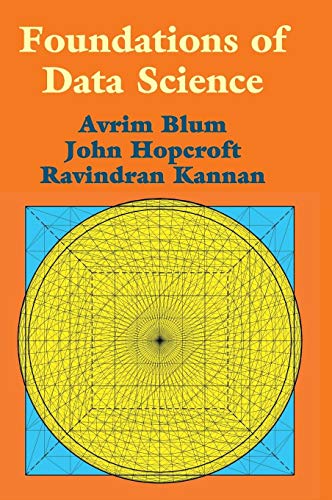

Most ebook files are in PDF format, so you can easily read them using various software such as Foxit Reader or directly on the Google Chrome browser.
Some ebook files are released by publishers in other formats such as .awz, .mobi, .epub, .fb2, etc. You may need to install specific software to read these formats on mobile/PC, such as Calibre.
Please read the tutorial at this link. https://ebooknice.com/page/post?id=faq
We offer FREE conversion to the popular formats you request; however, this may take some time. Therefore, right after payment, please email us, and we will try to provide the service as quickly as possible.
For some exceptional file formats or broken links (if any), please refrain from opening any disputes. Instead, email us first, and we will try to assist within a maximum of 6 hours.
EbookNice Team

Status:
Available4.7
16 reviews
ISBN 13: 9781108485067
Author: Avrim Blum, John Hopcroft, Ravindran Kannan
This book provides an introduction to the mathematical and algorithmic foundations of data science, including machine learning, high-dimensional geometry, and analysis of large networks. Topics include the counterintuitive nature of data in high dimensions, important linear algebraic techniques such as singular value decomposition, the theory of random walks and Markov chains, the fundamentals of and important algorithms for machine learning, algorithms and analysis for clustering, probabilistic models for large networks, representation learning including topic modelling and non-negative matrix factorization, wavelets and compressed sensing. Important probabilistic techniques are developed including the law of large numbers, tail inequalities, analysis of random projections, generalization guarantees in machine learning, and moment methods for analysis of phase transitions in large random graphs. Additionally, important structural and complexity measures are discussed such as matrix norms and VC-dimension. This book is suitable for both undergraduate and graduate courses in the design and analysis of algorithms for data.
1 Introduction
2 High-Dimensional Space
2.1 Introduction
2.2 The Law of Large Numbers
2.3 The Geometry of High Dimensions
2.4 Properties of the Unit Ball
2.5 Generating Points Uniformly at Random from a Ball
2.6 Gaussians in High Dimension
2.7 Random Projection and Johnson-Lindenstrauss Lemma
2.8 Separating Gaussians
2.9 Fitting a Spherical Gaussian to Data
2.10 Bibliographic Notes
2.11 Exercises
3 Best-Fit Subspaces and Singular Value Decomposition (SVD)
3.1 Introduction
3.2 Preliminaries
3.3 Singular Vectors
3.4 Singular Value Decomposition (SVD)
3.5 Best Rank-k Approximations
3.6 Left Singular Vectors
3.7 Power Method for Singular Value Decomposition
3.8 Singular Vectors and Eigenvectors
3.9 Applications of Singular Value Decomposition
3.10 Bibliographic Notes
3.11 Exercises
4 Random Walks and Markov Chains
4.1 Stationary Distribution
4.2 Markov Chain Monte Carlo
4.3 Areas and Volumes
4.4 Convergence of Random Walks on Undirected Graphs
4.5 Electrical Networks and Random Walks
4.6 Random Walks on Undirected Graphs with Unit Edge Weights
4.7 Random Walks in Euclidean Space
4.8 The Web as a Markov Chain
4.9 Bibliographic Notes
4.10 Exercises
5 Machine Learning
5.1 Introduction
5.2 The Perceptron Algorithm
5.3 Kernel Functions and Nonlinearly Separable Data
5.4 Generalizing to New Data
5.5 VC-Dimension
5.6 VC-Dimension and Machine Learning
5.7 Other Measures of Complexity
5.8 Deep Learning
5.9 Gradient Descent
5.10 Online Learning
5.11 Boosting
5.12 Further Current Directions
5.13 Bibliographic Notes
5.14 Exercises
6 Algorithms for Massive Data Problems: Streaming, Sketching, and Sampling
6.1 Introduction
6.2 Frequency Moments of Data Streams
6.3 Matrix Algorithms Using Sampling
6.4 Sketches of Documents
6.5 Bibliographic Notes
6.6 Exercises
7 Clustering
7.1 Introduction
7.2 k-Means Clustering
7.3 k-Center Clustering
7.4 Finding Low-Error Clusterings
7.5 Spectral Clustering
7.6 Approximation Stability
7.7 High-Density Clusters
7.8 Kernel Methods
7.9 Recursive Clustering Based on Sparse Cuts
7.10 Dense Submatrices and Communities
7.11 Community Finding and Graph Partitioning
7.12 Spectral Clustering Applied to Social Networks
7.13 Bibliographic Notes
7.14 Exercises
8 Random Graphs
8.1 The G(n, p) Model
8.2 Phase Transitions
8.3 Giant Component
8.4 Cycles and Full Connectivity
8.5 Phase Transitions for Increasing Properties
8.6 Branching Processes
8.7 CNF-SAT
8.8 Nonuniform Models of Random Graphs
8.9 Growth Models
8.10 Small-World Graphs
8.11 Bibliographic Notes
8.12 Exercises
9 Topic Models, Nonnegative Matrix Factorization, Hidden Markov Models, and Graphical Models
9.1 Topic Models
9.2 An Idealized Model
9.3 Nonnegative Matrix Factorization
9.4 NMF with Anchor Terms
9.5 Hard and Soft Clustering
9.6 The Latent Dirichlet Allocation Model for Topic Modeling
9.7 The Dominant Admixture Model
9.8 Formal Assumptions
9.9 Finding the Term-Topic Matrix
9.10 Hidden Markov Models
9.11 Graphical Models and Belief Propagation
9.12 Bayesian or Belief Networks
9.13 Markov Random Fields
9.14 Factor Graphs
9.15 Tree Algorithms
9.16 Message Passing in General Graphs
9.17 Warning Propagation
9.18 Correlation between Variables
9.19 Bibliographic Notes
9.20 Exercises
10 Other Topics
10.1 Ranking and Social Choice
10.2 Compressed Sensing and Sparse Vectors
10.3 Applications
10.4 An Uncertainty Principle
10.5 Gradient
10.6 Linear Programming
10.7 Integer Optimization
10.8 Semi-Definite Programming
10.9 Bibliographic Notes
10.10 Exercises
11 Wavelets
11.1 Dilation
11.2 The Haar Wavelet
11.3 Wavelet Systems
11.4 Solving the Dilation Equation
11.5 Conditions on the Dilation Equation
11.6 Derivation of the Wavelets from the Scaling Function
11.7 Sufficient Conditions for the Wavelets to Be Orthogonal
11.8 Expressing a Function in Terms of Wavelets
11.9 Designing a Wavelet System
11.10 Applications
11.11 Bibliographic Notes
11.12 Exercises
12 Background Material
12.1 Definitions and Notation
12.2 Useful Relations
12.3 Useful Inequalities
12.4 Probability
12.5 Bounds on Tail Probability
12.6 Applications of the Tail Bound
12.7 Eigenvalues and Eigenvectors
12.8 Generating Functions
12.9 Miscellaneous
12.10 Exercises
Bibliography
foundations of data science ravi kannan
foundations of statistics for data scientists with r and python
foundations of data science and engineering
foundations of data science by hopcroft and kannan
foundations of data science john hopcroft & ravindran kannan
foundations of data science
Tags: Avrim Blum, John Hopcroft, Ravindran Kannan, Kannan, Foundations